Kids Play Stage
Are you wondering if the way your child plays is normal for its age?
Playtime is more than a fun activity, it's a learning experience that helps your child develop.
Keep reading to learn about the 6 stages of play and the different types of play that help develop social, emotional, and cognitive skills!
- 6 Stages of Play
- Sensory Play
- Pretend/Dramatic Play
- Constructive Play
- Outdoor/Physical Play
- Creative Play
- Creative Play Ideas & Activities
6 Stages of Play
Like everything else in life, play comes in different stages. How your child plays will change, depending upon their age.
Unoccupied Play (Birth-3 Months)
This type of play is what children do from the ages of birth to three months. It may not look like play to the outside observer. It may look like movements that serve no purpose, but those movements are considered a type of play and they will help your child with their later types of play (1).
This kind of play can be as simple as kicking their legs or studying their feet.
Solitary Play (Birth-2 Years)
Solitary play happens from birth to two years old — it is really popular with toddlers. As the name implies, solitary play is something a child does by itself. It's a great method of play for shy kids and it's perfect for their still undeveloped communication ability.
This type of play is crucial because it helps your child learn how to entertain itself, which is an important skill to learn. You don't want to have a child that needs to be constantly entertained by things or other people — you want them to be able to do that for themselves.
Spectator/Onlooker Behavior (2 Years)
This kind of play begins around the age of 2, although it can be done long after that too. In this type of play, a child watches other children play without participating. It's a way of observing what happens and for them to learn by watching the others.
Sometimes the kids might ask questions and they'll definitely be interested in what's happening, but they won't take any initiative to join the fun. Parents can sometimes feel a little uncomfortable when they see this, thinking there is something wrong with their child, but it's a completely normal phase of development.
Children who aren't social enough yet to join in with the fun with other kids can benefit from onlooker play. It can give them the confidence to take their play to the next level with other kids involved.
Parallel Play (2+ Years)
Parallel play typically begins somewhere around the age of two years and can last much longer. It's when two or more children are in the same room playing in close proximity, but not necessarily with each other. Rather, it's more of an imitation — while they are playing separately they do notice each other and might even mirror the other's actions.
It gives children a good way to learn about manners, taking turns, and being a good playmate. And it shows that a child is starting to want to hang out with other children.
Associate Play (3-4 Years)
From three to four years old, associate play is another key type of play children will experience. In some ways, this type of play is similar to parallel play because children will also be playing separately.
What's different is that while they are playing separately, they are involved with each other too, working toward a common goal. They'll be working on their own tasks while they talk and socialize with one another. It's one of the ways that children first learn how to form and keep friendships.
Cooperative Play (4+ Years)
Cooperative play is what kids who are generally four or more years old will engage in. This is kind of a mash-up of all the stages. It's where everything they've learned from all the other stages of play come together.
This is when they start to share toys and come up with rules for their organized play. You'll see your child start to make real friends and they'll have favorite playmates as well in preschool and kindergarten.
Sensory Play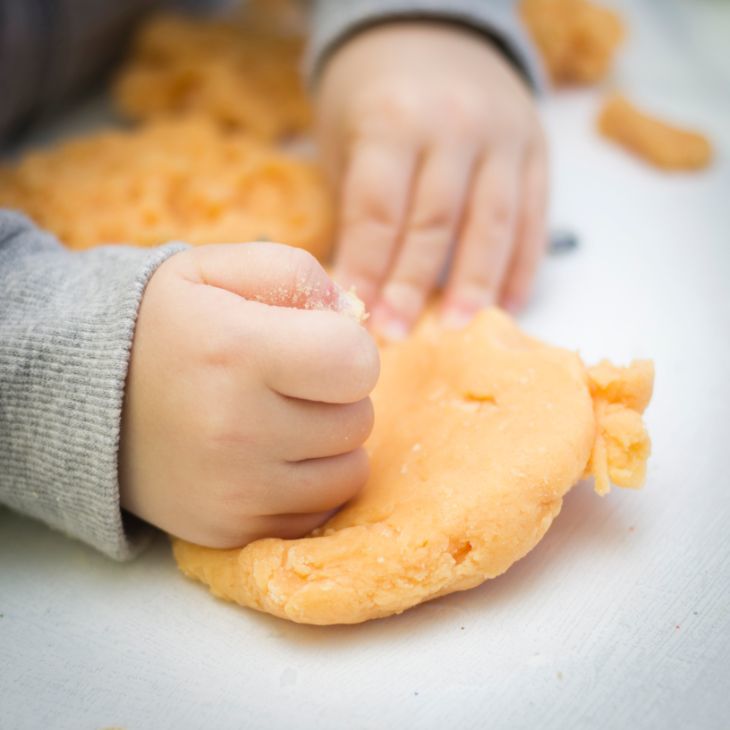
With this type of play, children utilize their five senses to learn about the world and whatever they are doing at the moment. Sensory play is instinctive for children, even babies. When you see a baby putting their fingers in their mouth or picking up something to look at it and feel the texture, that's sensory play.
This type of play involves any activity that involves sight, hearing, touch, smell, or taste.
Sensory play encourages investigation and exploration, allowing children to come up with their own conclusions about the world around them.
Tips for Sensory Play
When your child is exploring sensory play, there are some things you need to know.
- Watch your child: Since part of sensory play involves a child exploring with their mouth, you need to watch them carefully to ensure there are no choking hazards. You should make sure to supervise sensory play.
- Make a sensory bin: For preschoolers, you can create sensory bins to keep them engaged. This can be done with a plastic box, a bag of dry rice, and some play toys like scoops.
- Take it outside: If your child's sensory play involves water or things like finger paint, you might want to contain the mess by taking the activities outside. Otherwise, you'll find yourself watching your child play while calculating in your mind how long the clean up will take you.
- Make sure to pick objects that are safe for your child: If your youngster is still putting things in their mouth, you should be leery of letting them play with inedible objects (2).
- Wear old clothes: Since sensory activities can get a bit messy, you should put your child in clothes you don't care about, and you should wear clothes you don't care about either. That way, if you get dragged into the playtime, you won't be ruining either of your clothes.
Pretend/Dramatic Play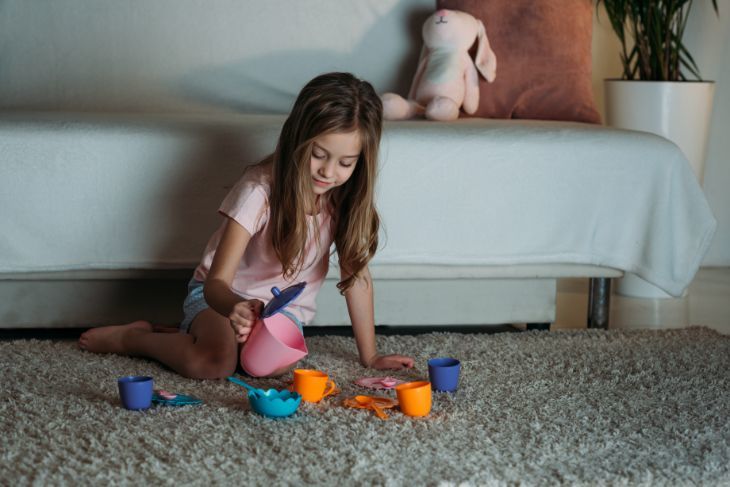
Kids of all ages love to pretend at school, at home, and pretty much anywhere else they go. Pretend play has two main components: fantasy play and sociodramatic play.
With fantasy play, your child won't stay in character, and they'll keep updating you about what kind of pretense they're keeping up. It often begins around age 2 and seems to reach its peak when a child is in preschool.
With sociodramatic play, a child is fully invested in the role it is playing. If your daughter, for instance, is pretending she's a princess, she's going to give it her all. For this type, your child will often base their storylines from things they've seen on their favorite tv shows or fairy tales.
Pretend play helps develop a child's social skills, emotional maturity, and cognitive development.
Pretend Play Ideas & Activities
- A tea party: Preschool-aged children will love throwing a tea party with you. Just set out a toy tea set and get started. Let your child take the lead, pouring you tea. You can set up extra chairs for their stuffed animals or dolls too.
- Be a vet: Does your child loved stuff animals? If so, set up their playtime, so it is compatible with their interests. Get out their stuffed animals and a toy doctor set. Tell your child your animals need to see the doctor. Any child over the age of 2 will love pretending to fix up their child.
- Pretend to be a dog: This is a favorite game with toddlers and even preschoolers. Both you and your child can get down on all fours, bark, and chase each other around while crawling. Kids are naturally drawn to animals, and dogs are often a favorite.
- Go in a laundry basket sailboat: This idea will appeal to toddlers but will still be fun even for early school-aged kids. You can decorate your laundry basket to look like a ship, even creating a flag for your boat if you want out of cardboard. Once the boat is ready your child can step in and set sail as you push them all over the floor.
- Set up a library: If your preschooler loves books, let them become a librarian. Set up some shelves of books at home and give them a fake stamping pad they can use to check out books for you to read to them. Or let them do story hour for you by letting them take the lead on trying to "read" a book to you.
Constructive Play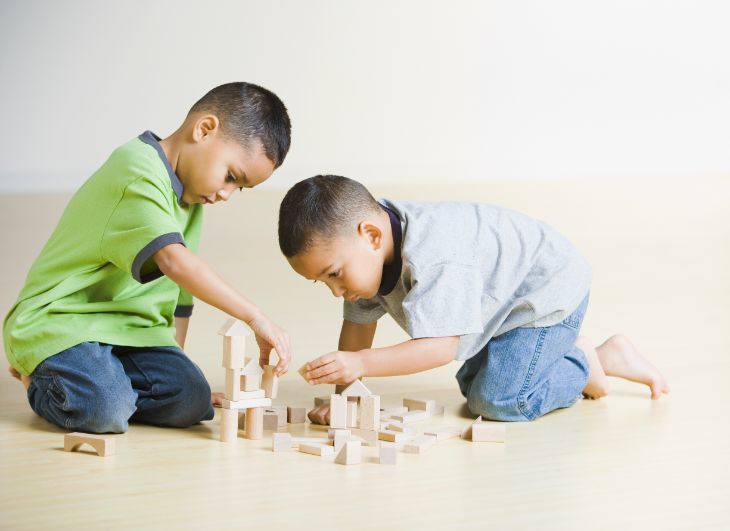
Constructive play is when kids try to use materials and toys around them to build and create things. This kind of play really seems to kick in around the age of 2 as your child's attention span becomes longer. They have enough concentration to play with one type of toy longer than they ever have.
Constructive play can help develop abstract thinking skills, fine motor skills, perseverance, and vision (3).
Constuctive Play Ideas & Activities
There are a lot of ways for your child to participate in constructive play, including:
- Putting together a train track.
- Building with blocks.
- Stacking cups or anything else.
- Making a fort out of blankets.
- Taking things apart and trying to put them back together.
- Sewing things by hand.
- Making small dams in the mud.
- Making and using ramps.
- Making a craft out of mosaic tiles.
- Creating a domino masterpiece.
- Making sand castles.
- Knitting or crocheting.
- Making things out of playdough or clay.
Outdoor/Physical Play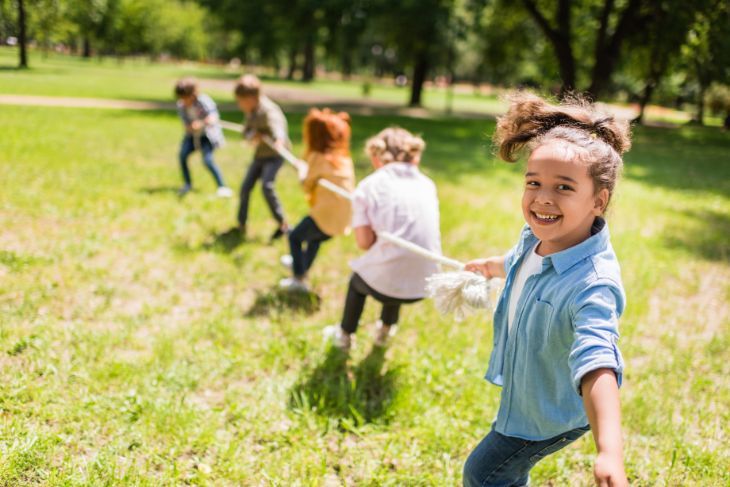
Physical play is an important aspect of your kid's childhood and development. Physical play is what your child does as they get up and move around while playing a game, learning a new skill, or exploring.
Physical play can begin at any age. Even babies can do a mild form of physical play — tummy time, which helps strengthen their muscles. After that, babies, toddlers, preschoolers, and school-age children all can participate in and benefit from physical play.
Physical Ideas & Activities
- Moving like different animals: Whether your toddler is hopping like a frog or crab walking around your house, they'll be working their bodies and having fun by engaging their minds. You can participate by doing it with them or giving them new animals to try to imitate.
- Balloons: Hitting around a balloon can entertain kids for hours. Toddlers can do it, but it remains fun for kids for years after that. You can make a game out of it by seeing how long you can keep the balloon in the air without letting it touch the ground.
- Make an obstacle course: Kids like to challenge themselves in fun ways, and what's more fun than a backyard or indoor obstacle course? You can make a simple course for your toddler and add more challenges for older kids. Make them crawl, jump, climb, run, and balance.
- Hula hooping: Hula hooping is a cool combination — it seems like you're playing a game, but it's actually great exercise. This is too advanced for toddlers and even some preschoolers. But once they are in school, you and your child can have backyard hula hooping competitions.
- Have a dance party: You can put on your favorite music and dance like nobody is watching with children of any age. Babies love to dance and toddlers will get into it too. Take turns putting on music you'll both enjoy.
- Get a plastic bat and whiffle ball: Let your child feel like a Major Leaguer by throwing some pitches to them and letting them learn how to bat. Little bats are available so your toddler can get into the fun.
- Play hide and seek: This can be done inside on a rainy day or in your backyard so they can get some outside time. This is fun for toddlers as well as older kids.
- Teach your child how to jump rope: This activity isn't as popular as it once was, but it is some of the best exercise out there. You can show your child how to jump rope with a small rope or find a partner to help twirl a bigger rope and show them more advanced moves.
Creative Play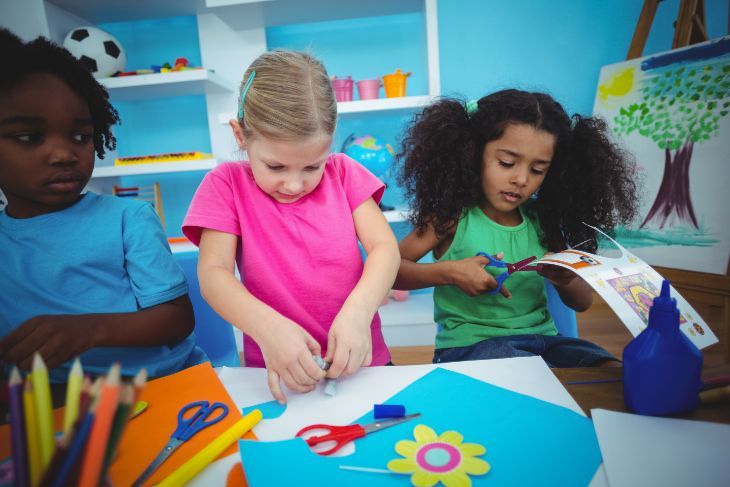
With creative play, your child does anything that sparks their imagination. This kind of play should be fun. This kind of play is a favorite of toddlers and preschool-aged children.
Creative play can help develop a child social, cognitive, and motor skills.
Creative Play Ideas & Activities
- Acting like a rock star: Let your child of any age unleash their inner performer by putting on their favorite song, dancing around, and singing into their hairbrush.
- Let them make music: Whether they are banging on a makeshift drum with a wooden spoon or blowing on a toy harmonica, kids love to make music. Exploring their love of music is great for all age groups.
- Play dress up: Let your child choose which careers they would like to explore by dressing up and acting out the part. Whether they are pretending to be a doctor, a gardener, or a shopkeeper, they'll have a blast. This kind of activity is fun for toddlers through elementary students.
- Reading: Picture books can help your child think creatively. Even though your toddler or preschooler won't be able to read, you can ask them to tell you the story. You'll both have fun listening to what they come up with.
- Baking: Baking is a great way for kids to test their creativity. They can follow instructions to make cupcakes and then decorate them in any fashion they want. Even toddlers can help with the decorations or pouring pre-measured ingredients into the mixing bowl.
- Cutting and pasting: Preschoolers and toddlers can use safety scissors to cut out shapes from old magazines and paste them onto pieces of paper. You'll get a kick out of seeing what interests them when you take a look at their final products. And they'll like showing off their handiwork.
- Gardening: Children of all ages are attracted to things that get their hands dirty, and the idea of growing their own food appeals to them. Because children like to see quick results for their efforts, it's best to choose plants that tend to grow quickly. You might also want a good mix of plants that grow underground, like carrots, and plants that grow above ground, like tomatoes.
Source: https://momlovesbest.com/stages-of-play







Tidak ada komentar:
Posting Komentar